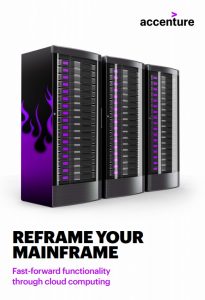Other parts of this series:
- Considerations for an effective cloud strategy
- Steering your journey to cloud with a few guiding principles
- Your journey to cloud: How to select your provider(s)
- Getting the Cloud Operating Model Right
- Key considerations when architecting and enabling your cloud platform
- Scaling the Cloud through a Well-Designed COE
Today, virtually every organisation is on a journey to cloud. But what’s the best way to map out and navigate that journey? And what opportunities and pitfalls should leaders watch out for along the way?

To help organisations in every sector answer these questions and more, my team and I have decided to publish a series of blog posts drawing on Accenture’s own journey to cloud experience. Over the coming months, we will examine every key aspect of cloud migration. And the place to start is with getting the cloud strategy right.
Why is an appropriate cloud strategy so vital? Conversations with our clients show clearly that – alongside the increased agility and flexibility that cloud technology can allow – the key common motivator for “moving to cloud” is to drive cost reduction. What is less clear is how to achieve these benefits and demonstrate them at pace, when a number of transformations do not see a return on investment in the first couple of years.
This means that any organisation embarking on a cloud journey should be clear on its primary motivations, and that this should be agreed to and consistent across the organisation.
A cloud strategy uniting business and IT goals …
So, how to set about creating an effective cloud strategy? The key here is for the IT function not to try to undertake it alone, but to bring key stakeholders from across the organisation along the journey.
This means shaping the cloud strategy through close engagement at the C-suite level, and – critically – aligning it with the business strategy, by showing how cloud can support and enhance the business’s delivery of its strategic goals. Think speed, innovation, cost reduction and the power of analytics spearheading the launch of new products in new markets. The result is a cloud strategy that’s not just aligned with the business strategy, but indivisible from it.
…and focusing on nine key components
With the whole enterprise aligned to the cloud strategy, it’s time to put it into effect. The first step is to identify the key components and capabilities that should be considered to facilitate execution. In Accenture’s view, a well-defined cloud strategy should cover nine core competency areas:
- Value: There should be a focus on the value created and the financial and non-financial benefits that cloud brings; this should include an enterprise-level value case with a clear plan for capturing, tracking and utilising benefits across the enterprise.
- People: A clear definition of the required capabilities, organisational design, governance models and a roadmap, with well-defined transition states, to reach your target state cloud organisation.
- Service: Your approach to purchasing services, service intake, cloud provider management and the build-out of a cloud service catalogue for your application teams to use.
- Application: A clear workload placement strategy and wave-based migration plan to provide control and clarity for migrating your workloads into the right place at the right time, providing stability, security and regulatory compliance as you migrate and build your workloads in the cloud.
- Development: Your approach to DevOps with a clearly defined development toolchain and route-to-live, together with a definition of how these processes and tools should integrate with your cloud platform.
- Infrastructure: A definition of the foundational infrastructure, or landing zone, and a clear plan of the cloud services that should be enabled to support your cloud workloads.
- Data: Definition of how your data should be structured in the cloud, the tooling required to process and store your data, and a clear strategy around how your data is to be migrated to your cloud platform.
- Operations: A well-defined operating model which details how your cloud workloads should be managed as they are transitioned to and run on your cloud platform(s); critically, this should include a clear definition of your FinOps operating model processes and tooling.
- Security: The standards, policies and procedures to adequately secure your workloads through appropriate preventative and detective controls integrated into your cloud platform.

Banking Cloud Altimeter | Volume 6: Banks need a flight plan to navigate the cloud.
LEARN MORELeverage the ecosystem…
As you set out to turn your cloud strategy into reality, these nine competency areas can help define your desired target state. But there may still be significant choices to make. For example, the cloud strategy doesn’t always indicate a specific choice of vendor. However, experience shows that a cloud strategy can be far more effective when the vendor(s) are identified from the start, since this helps to maintain clear direction for the organisation.
Just as crucial, having the vendor(s) identified allows the formation of key relationships – where you are able to focus, together, on meeting the goals and motivations that are set out in your strategy. Being able to leverage a provider’s experience, and give clear direction on workload placement and capabilities required, means you don’t just have a technology conversation about cloud, but instead a conversation on how to support your whole organisation in the business and cloud strategy that you’ve set out to deliver.
The journey continues
Finally, once you’ve defined your strategic approach and considered your organisation’s approach to the nine core cloud competency areas, don’t just assume it’s “job done”. You should then establish the mechanism through which you can review and track your progress towards your desired target state in the cloud – while also maintaining a relentless focus on delivering business value through cloud.
To learn more read “Mainframe Modernization: The Benefits of Cloud in a Mainframe Environment“.











